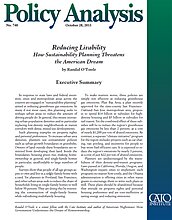Owners of land outside these boundaries are restricted from developing their land. Inside the boundaries, housing prices rise, making homeownership in general, and single-family homes in particular, unaffordable to large numbers of people.
Surveys show that people of all age groups aspire to own and live in a single-family home with a yard. Yet planners in Portland, San Francisco, and other urban areas seek to reduce the share of households living in single-family homes to well below 50 percent. They are doing this by restricting the construction of single-family homes while subsidizing multifamily housing. To make matters worse, these policies are simply not effective at reducing green house gas emissions. Plan Bay Area, a plan recently approved for the nine-county San Francisco–Oakland–San Jose metropolitan area, proposes to spend $14 billion in subsidies for high density housing and $5 billion in subsidies for rail transit. Yet the combined effect of these subsidies will be to reduce the region’s green house gas emissions by less than 2 percent, at a cost of nearly $1,200 per ton of abated emissions. By contrast, a separate “climate initiative” program for the region includes projects such as car sharing, van pooling, and incentives for people to buy more fuel-efficient cars. It is expected to reduce the region’s emissions by nearly 3 percent, at a cost of just $22 per ton of abated emissions. Planners are undiscouraged by the wastefulness of their density-and-transit programs.
Laws passed in California, Florida, Oregon, and Washington require cities to implement such programs no matter how costly, and the Obama administration is offering cities in other states grants to encourage them to write such plans as well. These plans should be abandoned because they intrude on property rights and personal housing preferences and are cost-ineffective at saving energy and reducing emissions.


